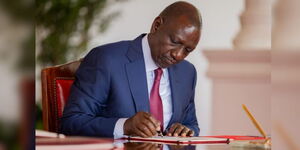Just weeks after Kenya made public the creation of the highly specialised police unit aimed at dealing with terror suspects who manage to sneak through the country’s porous border, Interior Principal Secretary Raymond Omollo has revealed a new plan to end the surge in irregular border crossings.
Omollo, through an opinion piece published in the Daily Nation on Wednesday, September 3, revealed a plan to institute new technology, including drone monitoring, as well as quick response units to enhance the country’s borders.
According to the PS, the government must establish interoperable platforms for real-time intelligence gathering and exchange across all agencies and borders. “We cannot simply seal our borders and call it a solution,” Omollo said.
Currently, the National Intelligence Service, as well as the Kenya Defence Forces' Intelligence Corps, are primarily responsible for collecting data and thwarting any planned terrorist attacks.
“Our border-related intelligence must be actionable, inclusive and, most importantly, anticipatory,” he asserted. Kenya shares a border with Somalia, Ethiopia, Uganda, Tanzania and South Sudan. However, the Somali and Ethiopian borders have been the subject of much discussion due to terror threats.
According to Omollo, this is part of a four-pillar strategy to counter the irregular migration that has often allowed people from neighbouring countries like Somalia to move freely and even plot terror attacks like the deadly Dusit D2 and the Garissa University attack that claimed over 100 lives.
Another aspect of Omollo’s proposed rethinking of border security is to quickly develop the country’s security infrastructure and increase the number of trained personnel to handle the emerging threats.
“We need to deploy a new generation of security technology, biometric systems, drone monitoring, and artificial intelligence-powered analytics to detect and deter illicit movements,” he said.
Perhaps what catches the eye most from Omollo’s proposal is empowering border communities. The PS argues that these communities are strategic partners, something that was highly featured in documentaries on the operations of the Special Operations Group (SOG).
The longstanding problem has been the feeling that the national government has no interest in developing border communities that are kilometres away from Nairobi. Whether true or not, this has resulted in apathy, and added to the fact that some border communities share ethnicity and at times family ties with others across the border, it becomes difficult to tame illegal crossings.
In fact, a recent International Organisation for Migration (IOM) report reveals that more Ethiopians than Somalis migrate irregularly to Kenya, often via Moyale and informal crossings. While exact annual totals aren’t specified, the report notes that in August 2024, Somali authorities recorded 23,314 migration movements, of which about 1,632 people were headed to Kenya.
Compare that with around 11,000 migrants recorded departing Ethiopia via the Southern Route (passing through Kenya), averaging about 1,100 departures per month between January and October 2024, and you see a pattern.
While it is unclear when the government will begin instituting these border control measures, Omollo insists it is an urgent matter that needs immediate action.












